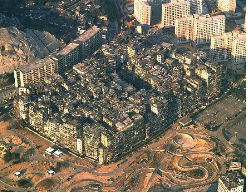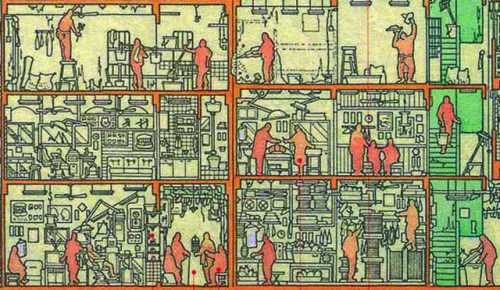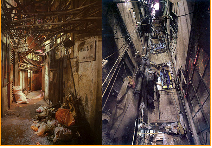The now extinct Kowloo n Walled City, also known as the City of Darkness may be a perverse prototype for green, sustainable living. Eco Brooklyn is constantly searching for green building alternatives applicable to New York City living, so when we came across Kowloon we almost fell off our seats.
n Walled City, also known as the City of Darkness may be a perverse prototype for green, sustainable living. Eco Brooklyn is constantly searching for green building alternatives applicable to New York City living, so when we came across Kowloon we almost fell off our seats.
It was Gotham City on cheap crack right out of a Blade Runner movie.
The Walled City was a densely populated, largely ungoverned settlement in Kowloon, Hong Kong that was once regarded as one of the most densely populated areas in the world.
It began as a Chinese Military fort and became its own enclave after the New Territories were released to Britain in 1898. Following the Japanese occupation during World War II the population increased dramatically and eventually contained 50,000 residents within 6.5 acres.
That averages 7,692 people per acre. The five boroughs of New York City, the most populous city in the USA, averages 41 people per acre. Manhattan, famous for being crowded, averages a mere 104 people per acre.
Another way of looking at it is how many square feet each 
person gets on average:
* New York City five boroughs – 1062 sq.ft./person
* Manhattan – 419 sq.ft./person
* Kowloon – 5 ½ sq.ft./person!!
The city was largely under its own contained “government” as neither the Chinese nor the British wanted to assume responsibility for the development.
Controlled by the infamous Triad gang, Kowloon had high rates of prostitution, gambling and drug use.
In terms of air and light in the narrow “streets”, residents were barely able to view the sky through the thick web of criss-crossing clotheslines and make shift electrical wires. Windows were a luxury.
As the city quickly grew, housing and factory blocks were added organically on top of each other using a mix of salvaged materials – cages, sheet metal and tarp – mixed in with cheap cinderblock construction. By the end, the Walled City had became a tall and near-solid cube of construction materials – over 300 interconnected 10 story buildings without any contribution from an architect, city planner or department of buildings!
Completely “off the grid”, the residents illegally taped into municipal electricity for juice and drilled 70 plus make shift wells within the city walls for water.
Another “sustainable” aspect of the Walled City is the transformability of the interior space. For example, bakery by day would change into a living room come night. Sixty percent of living spaces where smaller than 230 square feet (about 20’x20’), and as the numbers above show, an average of five people would share that space.
Kowloon is an example of anarchist building that, despite what it lacked in basic necessity, easy access to running water and waste disposal management, was a community that existed; it supported of about 50,000 for over forty years, from the 1950’s until 1992.
That is sustainable in it’s own weird way.
And it would have lasted longer if it hadn’t been forcibly demolished in 1992 and replaced with a park.
The Kowloon Walled City was obviously a dismal place full of prostitution, murder, corruption and drug use. You could argue the citizens of the Walled City only submitted themselves to these conditions out of desperation. Although this city emerged organically, it could be more a cancerous tumor than a blissfully natural city, sucking in every resource in its vicinity and essentially capturing its inhabitants.
But New York Green contractors can learn from it.
Despite the terrible conditions of human life, certain aspects are worth looking at from a green building perspective. This is cluster housing at the most extreme, reducing the amount of space a person needs to the bare bone minimum. The small, multi-use spaces is a key element of good green design.
As a whole, as the opposite of a sprawling suburbia, the city drastically reduced it’s physical footprint on the planet, giving an example of extreme cluster housing.
The fact that so much of the building materials were salvaged reduced the materials consumed to build. Poor people’s use of salvaged materials are acts of necessity but nonetheless are crucial components of green building.
Of course, the Walled City, as an un-planned, un-designed structure, could have gone very wrong but for the most part it stayed standing, a testament that logical simple building, using basic low cost materials does work.
I don’t have the numbers but I know the embodied energy to build this city was drastically less than a comparable city today.
Is it possible that if there was designed applied to these same ideas of small, transformable spaces that a livable, functioning community could exist? Perhaps with the addition of good design and planning The Walled City would be used as interesting model for future urban development. It has provided some very interesting examples of what is possible. Maybe not safe or even desirable, but we can now definitely say that such a city is possible and extract from that experiment elements that worked (or didn’t).

